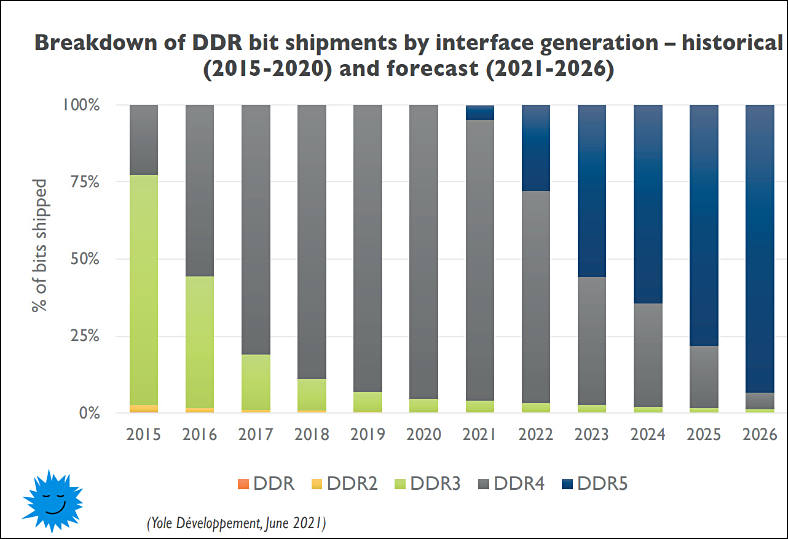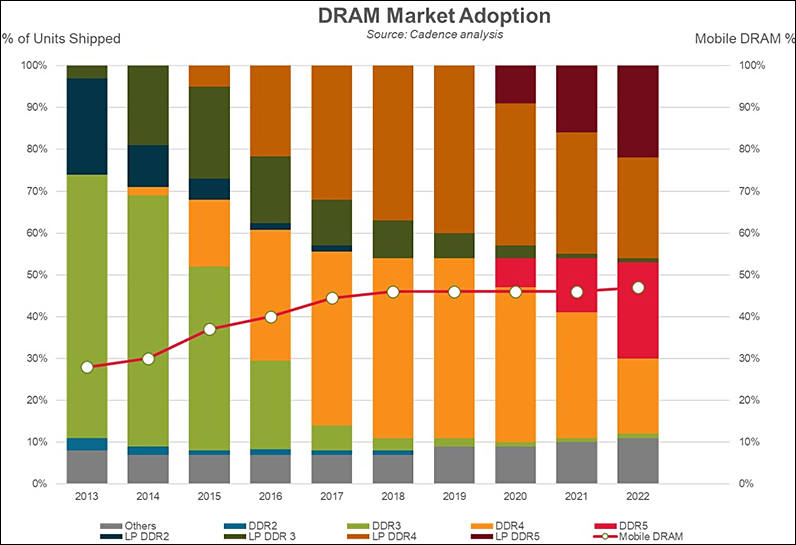
It allows to keep PV going, with more focus towards AI, but keeping be one of the few truly independent places.
-
Rambus now has working prototypes of DDR5 , the next major interface for DRAM dual in-line memory modules (DIMMs). The register clock drivers and data buffers could help double the throughput of main memory in servers, probably starting in 2019 — and they are already sparking a debate about the future of computing.
The Jedec standards group plans to release before June the DDR5 spec as the default memory interface for next-generation servers. However, some analysts note it comes at a time of emerging alternatives in persistent memories, new computer architectures and chip stacks.
“To the best of our knowledge, we are the first to have functional DDR5 DIMM chip sets in the lab. We are expecting production in 2019, and we want to be first to market to help partners bring up the technology”
DDR5 is expected to support data rates up to 6.4 Gbits/second delivering 51.2 GBytes/s max, up from 3.2 Gbits and 25.6 GBytes/s for today’s DDR4. The new version will push the 64-bit link down to 1.1V and burst lengths to 16 bits from 1.2V and 8 bits. In addition, DDR5 lets voltage regulators ride on the memory card rather than the motherboard.
CPU vendors are expected to expand the number of DDR channels on their processors from 12 to 16. That could drive main memory sizes to 128 Gbytes from 64 GB today.
The DDR5 standard will arrive about the same time Jedec releases its NVMDIMM-p interface for memory modules supporting a mix of DRAM and persistent memory. Intel said it will roll out server DIMMs next year using its 3D XPoint chips.
A lot of people don’t think DDR5 will be the next-generation memory interface. Process technology shrinks for DRAMs are approaching the physical limits of its core capacitors, leading experts to project the end the memory designs in five to ten years. Higher error rates are already requiring correcting code circuitry on the chips.
-
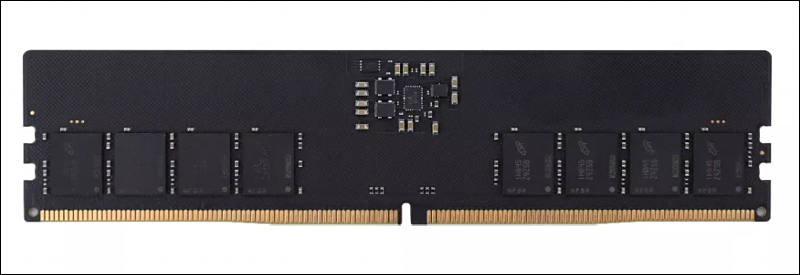
Colorful specialists are intensively testing prototypes of DDR5 memory in order to be in time exactly for the debut of new Intel products. At the same time, in its material, the company recalls that, despite the external similarity of DDR5 and DDR4 RAM modules, as well as the presence of the same number of contacts, they will be incompatible, since the design and arrangement of contacts for two generations of memory are different.
In addition to a different layout, DDR5 memory is distinguished by the presence of an integrated voltage regulator, which should have a positive effect on the efficiency of the modules, lower power consumption, and improved overclocking mechanisms.
In addition, the manufacturer announces significant improvements in terms of the effective frequency of DDR5 memory, which at first will vary from 4800 to 6400 MHz, as well as an increased density of 64 Gbit DRAM chips, which favorably distinguishes the new generation of memory from the previous one. ...
It is expected that the first DDR5 memory modules will debut in conjunction with desktop processors of the Alder Lake-S family and motherboards based on the Z690 system logic set, which, however, in addition to DDR5 memory modules, will also support DDR4, depending on the model.

 sa18371.jpg800 x 275 - 26K
sa18371.jpg800 x 275 - 26K -
512GB modules for datacenters
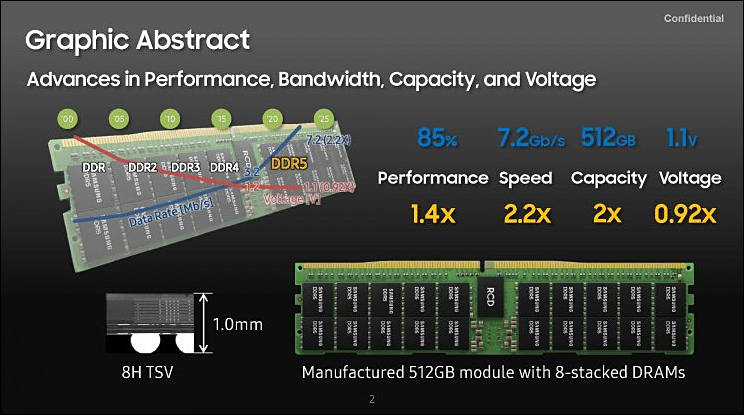
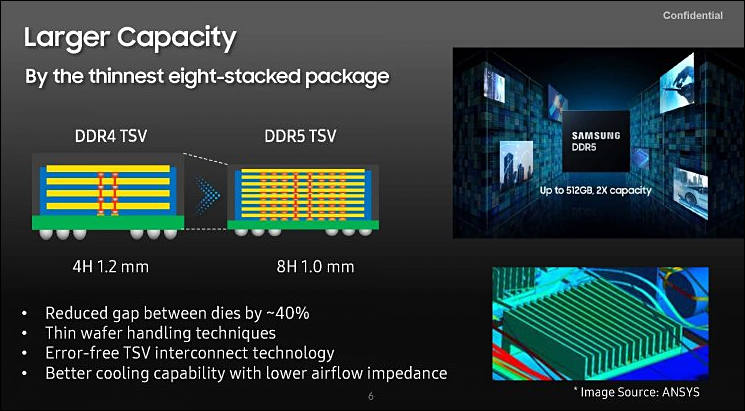

 sa18050.jpg744 x 415 - 57K
sa18050.jpg744 x 415 - 57K
 sa18051.jpg745 x 411 - 62K
sa18051.jpg745 x 411 - 62K -
“The operating temperature of DDR5 modules can be significantly higher than that of DDR4 modules, since the power regulation system has been moved from the motherboards to the memory strips themselves. As a result, they produce much more heat ” - commented George Makris, Corsair's advertising director.
Whole idea is bad. As now cheaper modules can be not only just slower but can have horrible power regulation.
-
First modules soon appear in retail
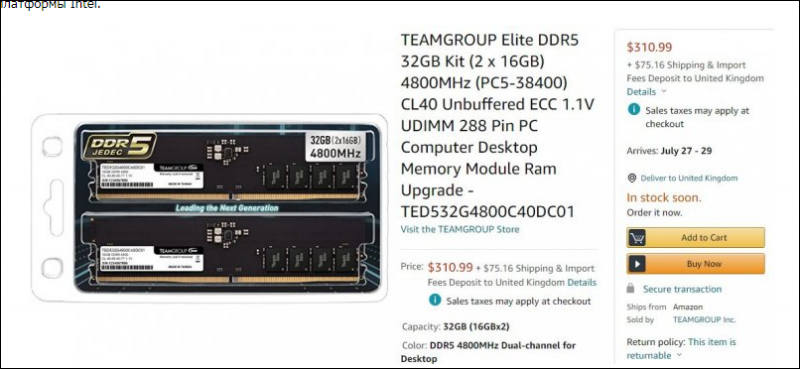
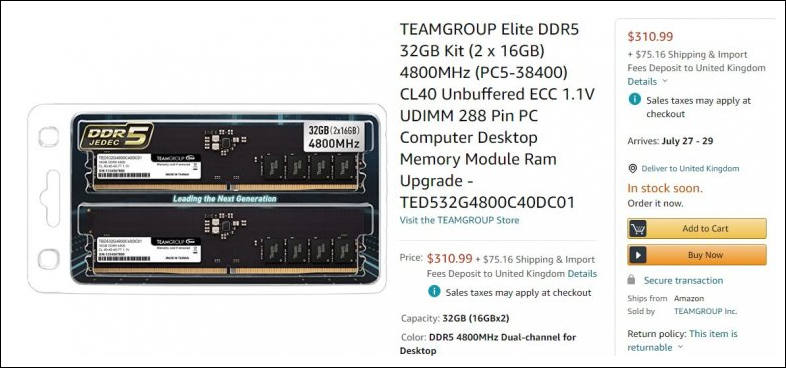

 sa17557.jpg800 x 369 - 46K
sa17557.jpg800 x 369 - 46K
 sa17558.jpg786 x 368 - 52K
sa17558.jpg786 x 368 - 52K -
Memory module firms including Kingston Technology, Adata Technology, Apacer Technology and Team Group all plan to launch their new-generation DDR5 memory series in the second half of 2021.
Kingston has delivered samples of its DDR5 modules to motherboard makers for testing and validation, and is scheduled to launch the lineup in the fourth quarter of this year, according to the memory module market leader. Along with the product launch, Kingston will introduce its brand-new gaming series.
Adata with its XPG gaming brand is also gearing up to launch its DDR5 overclocking memory in the third quarter of 2021, according to the Taiwan-based maker. The new DDR5 series memory modules will feature speeds between 6000MHz and 7400MHz, higher than the JEDEC 4800MHz native speeds, the company claimed.
Apacer has introduced its DDR5 gaming modules that run at 6,400MHz speed, while Team Group has already offered engineering samples of its DDR5 products and is in touch with major motherboard makers for the product validation, according to the companies.
Motherboard makers have already kicked off validation for DDR5 products ahead of schedule.
-
Next-generation DDR5 memory is expected to be employed in consumer electronics devices starting as early as the second half of 2021, despite its still-early stage of deployment, according to industry sources.
Motherboard makers have kicked off validation for DDR5 products ahead of schedule, said the sources, adding that DDR5 SO-DIMM modules for use in notebooks and mini PCs are also being validated by the motherboard firms.
Motherboard companies are all striving to be among the first players capable of providing solutions based on new-generation PC processors ready for verification tests, the sources indicated. Both AMD and Intel are expected to provide their next-generation PC processors supporting DDR5 memory by 2022.
-
ADAPA PR
ADATA Technology, a manufacturer of high-performance DRAM modules, NAND Flash products, mobile accessories, gaming products, electric power trains, and industrial solutions, is gearing up to bring next-generation DDR5 memory modules to market to offers users a significant upgrade in speed, capacity, as well as increased bandwidth per CPU cores. ADATA has been working closely with two leading motherboard makers, MSI and Gigabyte, to ensure an optimized experience through ensuring synergies between ADATA’s DDR5 modules and their latest Intel platforms.

In parallel to developing the new memory modules, ADATA has also been working closely with two leading motherboard makers MSI and Gigabyte, its long-term strategic partners, to ensure their new platforms can take full advantage of DDR5. Among other initiatives, ADATA, MSI, and Gigabyte have been conducting joint testing and research to guarantee optimum DDR5 overclocking on the latest Intel platforms to meet gamers’ discerning standards. ADATA and the motherboard above makers will be launching DDR5 modules and DDR5-compliant motherboards simultaneously to offer high performance to a wide range of users, including enterprises, gamers, and creators, to name a few.
“As longtime strategic partners, Gigabyte and ADATA have committed themselves to test DRAM products to ensure exceptional overclocking performance on the latest Intel platforms,” said a representative from Gigabyte. “With next-generation DDR5, our commitment is no different, and we continue to verify the synergy of our products to deliver smooth operations and reliability.”
“The strategic partnership between MSI and ADATA is a complementary relationship that brings together ADATA’s leading expertise in memory and MSI’s core competencies in motherboards and PCs,” said a representative from MSI. “Together, we work hand in hand to validate that our products can work in combination to offer maximized DDR5 performance on the latest Intel platforms.”
“ADATA has always looked to progress technology to the next level, and DDR5 is our next objective in that pursuit,” said Nick Dai, Director of Product Marketing at ADATA. “In our journeys to innovate and progress technology, we have never been alone in those endeavors and are lucky to have MSI and Gigabyte as trusted partners to bring to market the best that technology has to offer.”
Faster Performance and Higher Capacities for the New Era in Tech
With the arrival of 5G networks, Wi-Fi 6, and processors with evermore cores, memory modules must keep up with these developments to ensure optimized computing. As a result, ADATA has been focused on developing next-generation DDR5 memory modules that will offer enhanced speeds, capacities, and increased bandwidth per CPU cores. ADATA’s DDR5 memory will deliver speeds of up to 8400MT/s and come in capacities of up to 64 GB. The modules will also come with error-correcting code (ECC) functionality for enhanced accuracy and reliability and power management functionality for improved energy efficiency with an energy consumption reduction of up to 1.1V.
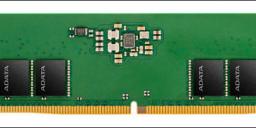
 sa16113.jpg800 x 218 - 34K
sa16113.jpg800 x 218 - 34K -
SK hynix strikes again
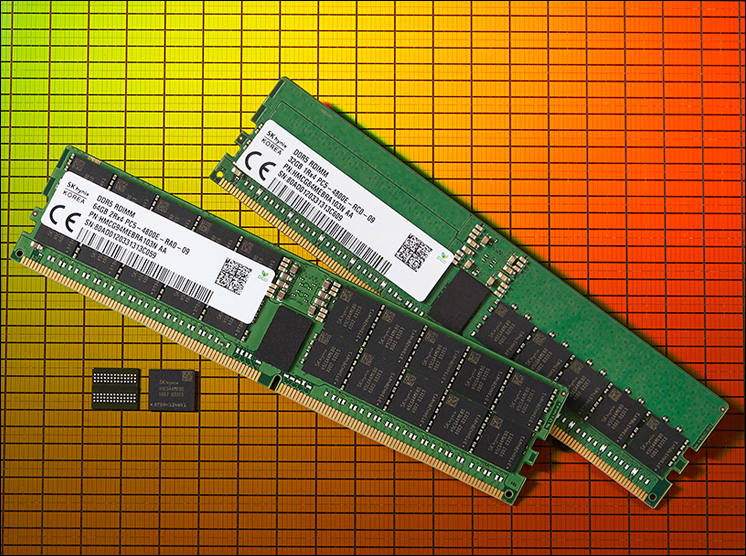
SK hynix's DDR5 supports transfer rate of 4,800 ~ 5,600 Megabit-per-second (Mbps), which is 1.8 times faster than the previous generation - DDR4. Its operating voltage is 1.1 V being lowered from 1.2 V of DDR4, which means that its power consumption is reduced by 20%.
Note that actual DDR4L memory runs at 1.05V.
The only area where slightly lower consumption matters is the servers with massive amount of memory, for usual desktops it does not matter at all, and for notebooks we won't see this memory for long time at leading brands products may be until DDR5L will come.

 sa14917.jpg746 x 556 - 153K
sa14917.jpg746 x 556 - 153K -
Official announcement
JEDEC Solid State Technology Association, the global leader in the development of standards for the microelectronics industry, today announced the publication of the widely-anticipated JESD79-5 DDR5 SDRAM standard. The standard addresses demand requirements being driven by intensive cloud and enterprise data center applications, providing developers with twice the performance and much improved power efficiency. JESD79-5 DDR5 is now available for download from the JEDEC website.
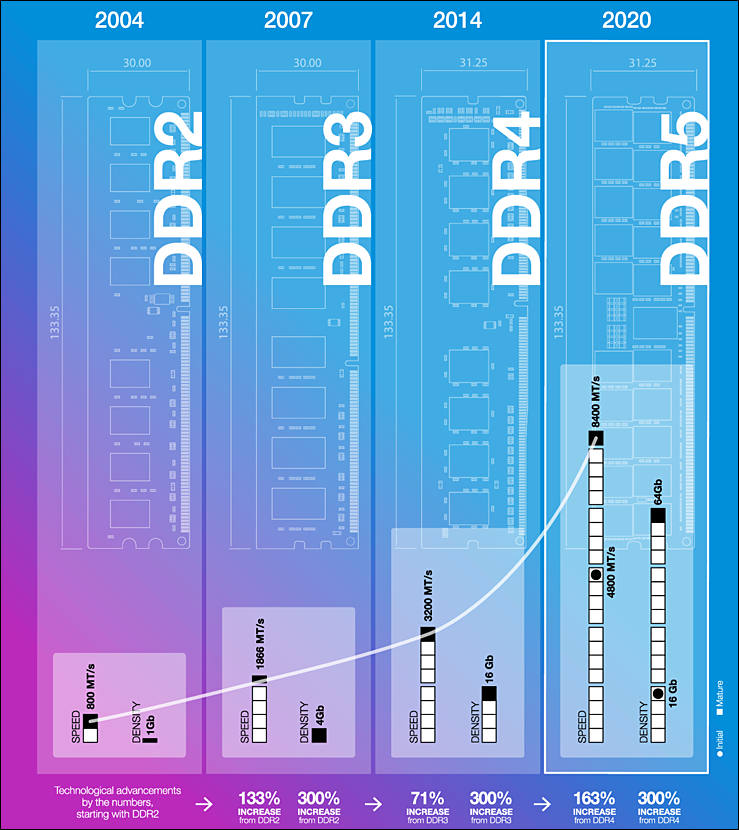
DDR5 was designed to meet increasing needs for efficient performance in a wide range of applications including client systems and high-performance servers. DDR5 incorporates memory technology that leverages and extends industry know-how and experience developing previous DDR memories. The standard is architected to enable scaling memory performance without degrading channel efficiency at higher speeds, which has been achieved by doubling the burst-length to BL16 and bank-count to 32 from 16. This revolutionary architecture provides better channel efficiency and higher application level performance that will enable the continued evolution of next-generation computing systems. In addition, the DDR5 DIMM has two 40-bit fully independent sub-channels on the same module for efficiency and improved reliability.
New features, such as DFE (Decision Feedback Equalization), enable IO speed scalability for higher bandwidth and improved performance. DDR5 supports double the bandwidth as compared to its predecessor, DDR4, and is expected to be launched at 4.8 Gbps (50% higher than DDR4's end of life speed of 3.2 Gbps).
Additional features include:
- Fine grain refresh feature: as compared to DDR4 all bank refresh improves 16 Gbps device latency. Same bank selfrefresh offers better performance by enabling some banks to refresh while others are in use.
- On-die ECC and other scaling features enable manufacturing on advanced process nodes.
- Improved power efficiency enabled by Vdd going from 1.2V to 1.1V as compared to DDR4.
- Use of the MIPIÒ Alliance I3C Basic specification for system management bus.
- At the module level, voltage regulator on DIMM design enables pay as you go scalability, better voltage tolerance for improved DRAM yields and the potential to further reduce power consumption.
"With several new performance, reliability and power saving modes implemented in its design, DDR5 is ready to support and enable next-generation technologies," said Desi Rhoden, Chairman JC-42 Memory Committee and Executive VP Montage Technology. "The tremendous dedication and effort on the part of more than 150 JEDEC member companies worldwide has resulted in a standard that addresses all aspects of the industry, including system requirements, manufacturing processes, circuit design, and simulation tools and test, greatly enhancing developers' abilities to innovate and advance a wide range of technological applications."
Industry Support for DDR5
"High-performance computing requires memory that can keep pace with the ever-increasing demands of today's processors. With the publication of the DDR5 standard, AMD can better design its products to meet the future demands of our customers and end-users," said Joe Macri, AMD Compute and Graphics CTO. "By working together on a single standard through JEDEC, the industry delivers a predictable cadence for memory bandwidth improvements, enabling the next generation of high-performance systems and applications."
"With the publication of JEDEC's DDR5 standard, we are entering a new era of DDR performance and capabilities. DDR5, developed with significant effort across the industry, marks a great leap forward in memory capability, for the first time delivering a 50% bandwidth jump at the onset of a new technology to meet the demands of AI and high performance compute," said Carolyn Duran, VP - Data Platforms Group, GM -- Memory and IO Technologies at Intel.
"Micron is proud to be a part of the JEDEC organization, which provides an efficient forum for cross-industry collaboration on leading-edge technology standards," said Frank Ross, JEDEC Board of Directors member and senior member of Technical Staff at Micron. "The DDR5 standard offers the industry a critical advancement in main memory performance to enable the next-generation of computing required to turn data into insight across cloud, enterprise, networking, high-performance computing and artificial intelligence applications."
"Samsung actively contributed to defining JEDEC's new DDR5 industry standard, recognizing that this new DDR5 framework is a critical turning point in the advancement of memory for servers, PCs and other major electronic devices," said Sangjoon Hwang, senior vice president of Memory Product Planning, Samsung Electronics. "We are delighted to see the timely release of this standard, and anticipate bringing our DDR5-standardized solutions to volume production in a timeframe that coincides with market demands," Hwang added.
"DDR5 is prepared to improve the Computing Performance by applying various features to overcome future technology scaling challenge and improve performance compared to DDR4. On this basis, DDR5 will lead the evolution of the data-centric era, and will play a pivotal role in the 4th Industrial Revolution," said Uksong Kang, Head of DRAM Product Planning at SK hynix, one of the JEDEC members. "SK hynix is opening up a new sector in the market through the development of the industry's first DDR5 that meets JEDEC standards. We have been working with many partners to verify DDR5 Ecosystem through development of test chips, and modules since 2018, and doing our best to secure mass-production levels in the second half of this year."

 sa13765.jpg739 x 830 - 117K
sa13765.jpg739 x 830 - 117K -
LPDDR5 started shipping
Micron offers 6, 8 and 12Gb chips packaging with speed being double of that of LPDDR4x.
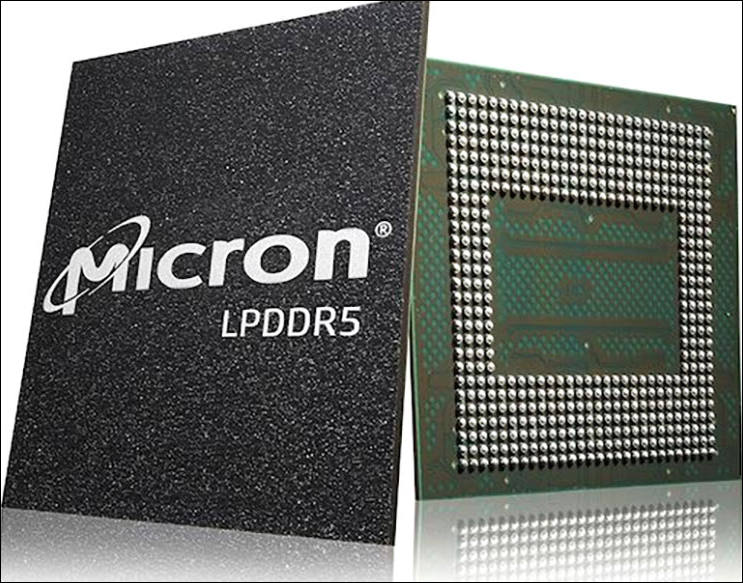

 sa12126.jpg743 x 583 - 97K
sa12126.jpg743 x 583 - 97K -
SK Hynix DDR5 RDIMM
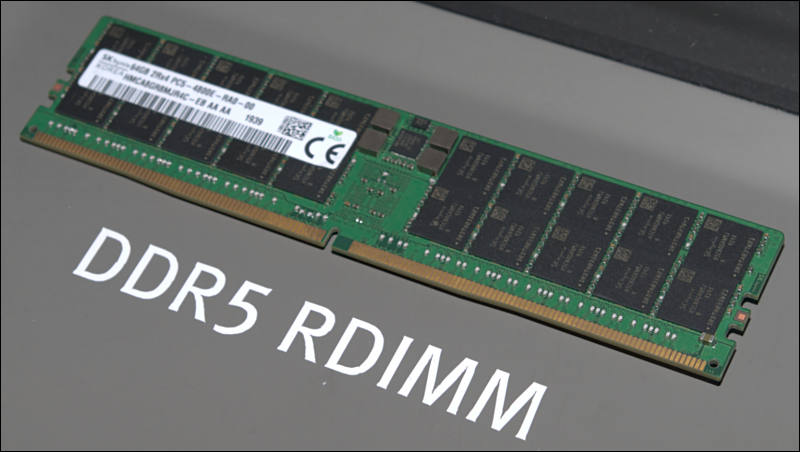
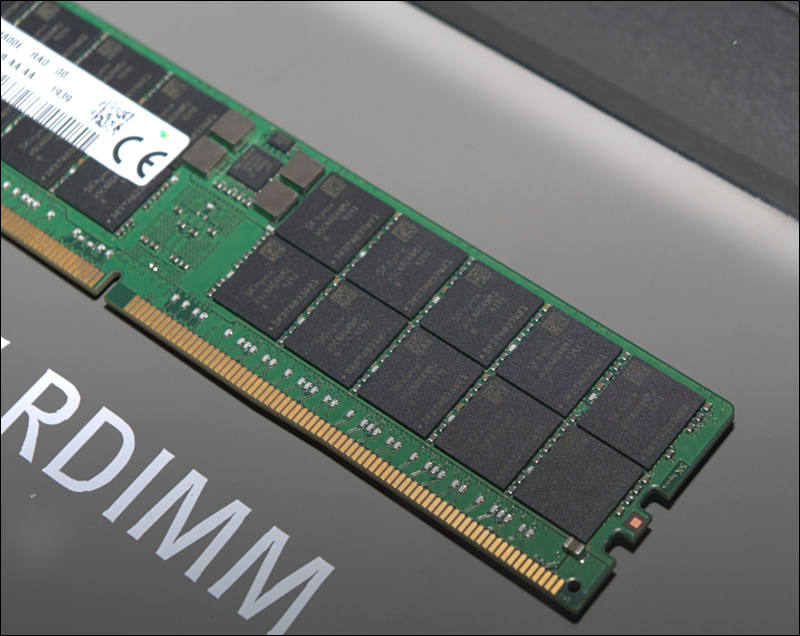

 sa11820.jpg800 x 452 - 46K
sa11820.jpg800 x 452 - 46K
 sa11821.jpg800 x 636 - 67K
sa11821.jpg800 x 636 - 67K -
Differences
VDD/VDDQ/VPP voltages are not default at 1.1v instead of 1.2v for DDR4. And they won't get lower, instead of all good modules they will be higher and on DDR4 levels. Ads it is physics that won't allow lower voltages.
Stick density can increase from 16GB to 64GB, yet default will be still 16Gb per stick max.
Prefetch length increased from 8n to 16n, is it'll be same initial delay as on DDR4, but idea to transfer more data at once, hence big cache on CPU will help.
-
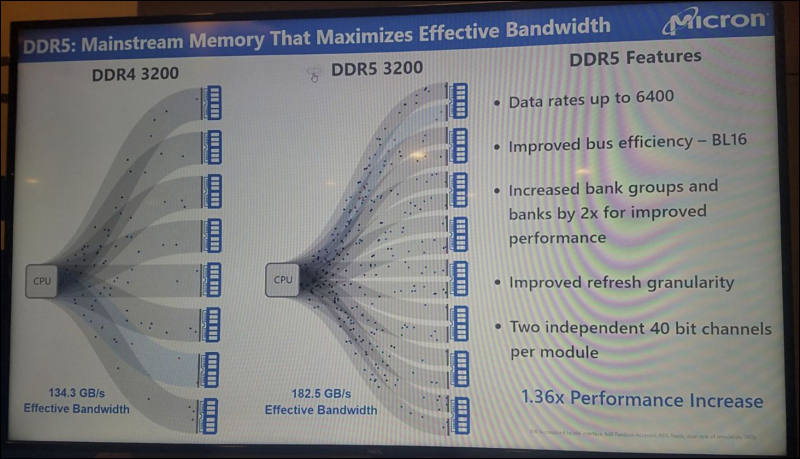
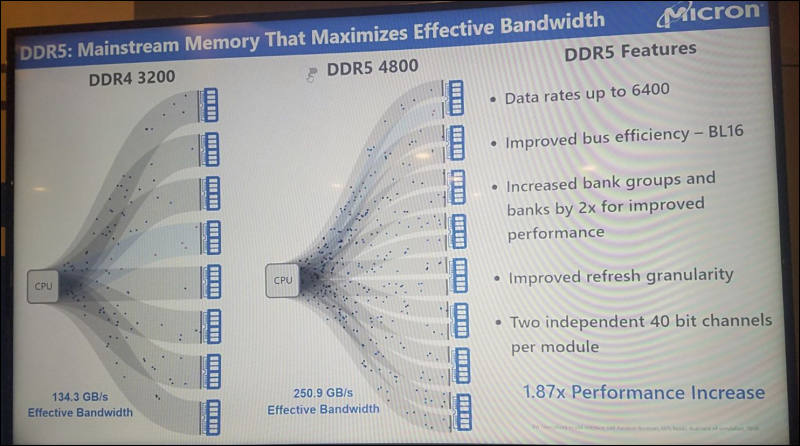
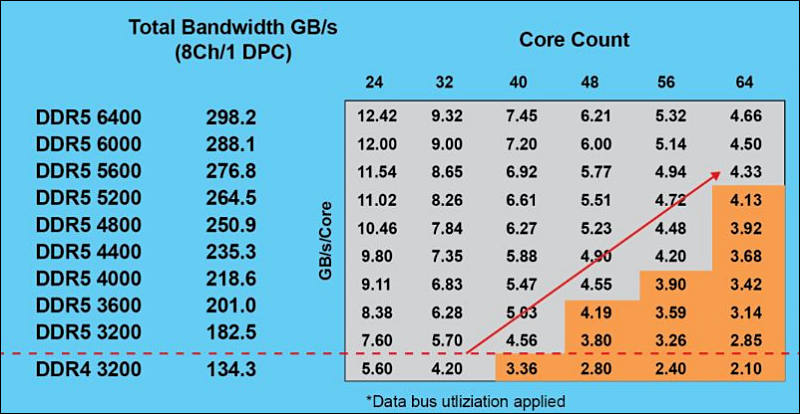
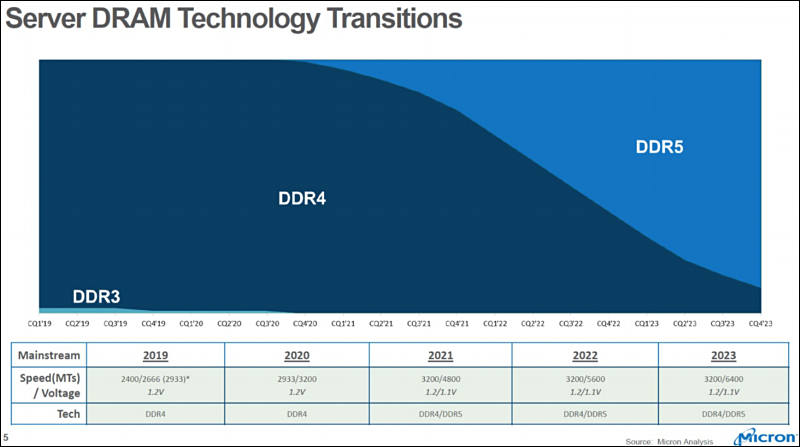

 sa11731.jpg800 x 446 - 62K
sa11731.jpg800 x 446 - 62K
 sa11732.jpg800 x 459 - 63K
sa11732.jpg800 x 459 - 63K
 sa11733.jpg800 x 414 - 71K
sa11733.jpg800 x 414 - 71K
 sa11734.jpg800 x 447 - 43K
sa11734.jpg800 x 447 - 43K -
Micron Technology has begun sampling DDR5 Registered DIMMs (RDIMM) based on its 1znm process technology, according to the company.
DDR5, the most technologically advanced DRAM to date, will enable the next generation of server workloads by delivering more than an 85% increase in memory performance, Micron noted. DDR5 doubles memory density while improving reliability at a time when data center system architects seek to supply rapidly growing processor core counts with increased memory bandwidth and capacity.
DDR5 will deliver more than a 1.85 times increase in performance compared to DDR4. DDR5 also enables the increased reliability, availability and serviceability (RAS) that modern data centers require, Micron indicated.
PR
Micron Technology, Inc. (MU) today announced that it has begun sampling DDR5 Registered DIMMs (RDIMM), based on its industry-leading 1znm process technology. DDR5, the most technologically advanced DRAM to date, will enable the next generation of server workloads by delivering more than an 85% increase in memory performance. DDR5 doubles memory density while improving reliability at a time when data center system architects seek to supply rapidly growing processor core counts with increased memory bandwidth and capacity.
“Data center workloads will be increasingly challenged to extract value from the accelerating growth of data across virtually all applications,” said Tom Eby, senior vice president and general manager of the Compute & Networking Business Unit at Micron. “The key to enabling these workloads is higher-performance, denser, higher-quality memory. Micron’s sampling of DDR5 RDIMMs represents a significant milestone, bringing the industry one step closer to unlocking the value in next-generation data-centric applications.”
Advanced workloads resulting from rapidly expanding datasets and compute-intensive applications have fueled processor core count growth which will be bandwidth-starved by current DRAM technology. DDR5 will deliver more than a 1.85 times increase in performance compared to DDR4. DDR5 also enables the increased reliability, availability and serviceability (RAS) that modern data centers require.
-
Hynix announced that it’s developed a 16GB DDR5 memory chip t- first to match the upcoming JEDEC standard for DDR5.
It must be noted that DDR5 memory uses less power while offering faster speeds than today’s DDR4 memory. SK Hynix says mass production isn’t scheduled to begin until 2020.
16GB SK Hynix memory solution supports data transfer speeds up to 5200 Mbps, which makes it about 60 percent faster than DDR4 memory, which supports speeds up to 3200 Mbps.
Howdy, Stranger!
It looks like you're new here. If you want to get involved, click one of these buttons!
Categories
- Topics List23,990
- Blog5,725
- General and News1,353
- Hacks and Patches1,153
- ↳ Top Settings33
- ↳ Beginners256
- ↳ Archives402
- ↳ Hacks News and Development56
- Cameras2,366
- ↳ Panasonic995
- ↳ Canon118
- ↳ Sony156
- ↳ Nikon96
- ↳ Pentax and Samsung70
- ↳ Olympus and Fujifilm100
- ↳ Compacts and Camcorders300
- ↳ Smartphones for video97
- ↳ Pro Video Cameras191
- ↳ BlackMagic and other raw cameras116
- Skill1,960
- ↳ Business and distribution66
- ↳ Preparation, scripts and legal38
- ↳ Art149
- ↳ Import, Convert, Exporting291
- ↳ Editors191
- ↳ Effects and stunts115
- ↳ Color grading197
- ↳ Sound and Music280
- ↳ Lighting96
- ↳ Software and storage tips266
- Gear5,420
- ↳ Filters, Adapters, Matte boxes344
- ↳ Lenses1,582
- ↳ Follow focus and gears93
- ↳ Sound499
- ↳ Lighting gear314
- ↳ Camera movement230
- ↳ Gimbals and copters302
- ↳ Rigs and related stuff273
- ↳ Power solutions83
- ↳ Monitors and viewfinders340
- ↳ Tripods and fluid heads139
- ↳ Storage286
- ↳ Computers and studio gear560
- ↳ VR and 3D248
- Showcase1,859
- Marketplace2,834
- Offtopic1,320


